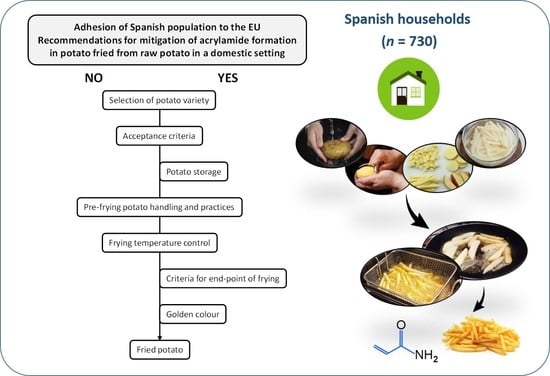Are Household Potato Frying Habits Suitable for Preventing Acrylamide Exposure?
Abstract
1. Introduction
2. Materials and Methods
2.1. Study Design
- Socio-demographic characteristics: gender, age group, nationality, type of household, number of individuals at home and number of individuals under 18 years old at home.
- Culinary habits: cooking experience.
- French fry consumption: characteristics of potatoes intended for frying (fresh or frozen, par-fried), frequency of french fry consumption and the way in which they are consumed.
- Fresh potato characteristics: place of purchase and type of fresh tubers (in-season or stored, washed or unwashed, bulk or bagged, labelled as “special for frying,” etc.), geographical origin, botanical variety and place of storage at home.
- Practices at the pre-frying stage: peeling, washing, soaking, adding salt and cutting preferences.
- Practices at the frying stage: kitchen utensil, frying oil characteristics, frying temperature, subjective ratio between the amount of food with respect to the dimensions of the frying utensil, defrosting prior to par-frying potatoes or frying from frozen and frying cycles.
- Post-frying practices: criterion for establishing the frying end-point, color and texture preferences; method for removing oil from fried food; criteria for stopping oil use in other frying cycles; cleaning procedures for oil reuse and oil storage.
2.2. Data Collection
2.3. Data Processing
3. Results and Discussion
3.1. Characteristics of the Participants
3.2. French Fry Consumption
3.3. Fresh Potato Characteristics
3.4. Practices Related to the Pre-Frying Stage
3.5. Practices Related to the Frying Stage
3.6. Practices Related to the Post-Frying Stage
4. Conclusions
Supplementary Materials
Author Contributions
Funding
Acknowledgments
Conflicts of Interest
References
- Bonwich, G.; Birch, C.S. European regulation of process contaminants in food. In Mitigation Contamination from Food Processing; Birch, C.S., Bonwick, G.A., Eds.; RSC: Cambridge, UK, 2019; pp. 1–16. [Google Scholar]
- Van Boekel, M.; Fogliano, V.; Pellegrini, N.; Stanton, C.; Scholz, G.; Lalljie, S.; Somoza, V.; Knorr, D.; Jasti, P.R.; Eisenbrand, G. A review on the beneficial aspects of food processing. Mol. Nutr. Food Res. 2010, 54, 1215–1247. [Google Scholar] [CrossRef]
- EFSA (European Food Safety Authority). Scientific opinion on acrylamide in food. EFSA J. 2015, 13, 4104. [Google Scholar]
- IARC (International Agency for Research on Cancer). Some industrial chemicals. In IARC Monographs on the Evaluation for Carcinogenic Risk of Chemicals to Humans; IARC: Lyon, France, 1994; Volume 60, pp. 435–453. [Google Scholar]
- EC (European Commission). Commission Regulation (EU) 2017/2158 of 20 November 2017 establishing mitigation measures and benchmark levels for the reduction of the presence of acrylamide in food. OJEU 2017, 304, 24–44. [Google Scholar]
- FDE (FoodDrinkEurope). 2019. Available online: https://www.fooddrinkeurope.eu/uploads/publications_documents/FoodDrinkEurope_Acrylamide_Toolbox_2019.pdf (accessed on 12 April 2020).
- Claeys, W.; De Meulenaer, B.; Huyghebaert, A.; Scippo, M.L.; Hoet, P.; Matthys, C. Reassessment of the acrylamide risk: Belgium as a case-study. Food Control 2016, 59, 628–635. [Google Scholar] [CrossRef]
- Powers, S.J.; Mottram, D.S.; Curtis, A.; Halford, N.G. Acrylamide levels in potato crisps in Europe from 2002 to 2016. Food Addit. Contam. Part A 2017, 34, 2085–2100. [Google Scholar] [CrossRef]
- Mesias, M.; Nouali, A.; Delgado-Andrade, C.; Morales, F.J. How far is the Spanish snack sector from meeting the acrylamide regulation 2017/2158? Foods 2020, 9, 247. [Google Scholar] [CrossRef]
- Langiano, E.; Ferrara, M.; Lanni, L.; Viscardi, V.; Abbatecola, A.M.; De Vito, E. Food safety at home: Knowledge and practices of consumers. Z. Gesundh. 2012, 20, 47–57. [Google Scholar] [CrossRef]
- FSA (Food Standards Agency). Acrylamide in the home: Home-Cooking Practices and Acrylamide Formation. 2017. Available online: https://www.food.gov.uk/research/research-projects/acrylamide-in-the-home-the-effects-of-home-cooking-on-acrylamide-generation (accessed on 14 April 2020).
- Mesías, M.; Holgado, F.; Márquez-Ruiz, G.; Morales, F.J. Impact of the characteristics of fresh potatoes available in-retail on exposure to acrylamide: Case study for French fries. Food Control 2017, 73, 1407–1414. [Google Scholar] [CrossRef]
- AECOSAN (Spanish Agency for Consumer Affairs, Food Safety and Nutrition). 2015. Available online: http://www.aecosan.msssi.gob.es/AECOSAN/web/seguridad_alimentaria/subdetalle/acrilamida.htm (accessed on 14 April 2020).
- EFSA (European Food Safety Authority). Special Eurobarometer Wave EB91.3. 2019. Available online: http://www.efsa.europa.eu/sites/default/files/corporate_publications/files/Eurobarometer2019_Food-safety-in-the-EU_Full-report.pdf (accessed on 12 April 2020).
- Romero, A.; Cuesta, C.; Sánchez-Muniz, F.J. Utilización de freidora doméstica entre universitarios madrileños. Aceptación de alimentos congelados fritos en aceite de oliva virgen extra, girasol y girasol alto oleico. Grasas Aceites 2001, 52, 38–44. [Google Scholar]
- Gatti, M.B.; Cabreriso, M.S.; Chain, P.; Coniglio, A.; Manin, M.; Ciappini, M.C. Evaluación de la frecuencia de consumo de alimentos fritos y de las técnicas de frituras domésticas en adultos rosarinos. Invenio 2015, 19, 155–165. [Google Scholar]
- Wood, K.; Carragher, J.; Davis, R. Australian consumer’s insights into potatoes-nutritional knowledge, perceptions and beliefs. Appetite 2017, 114, 169–174. [Google Scholar] [CrossRef] [PubMed]
- Van den Berg, M.H.; Overbeek, A.; van der Pal, H.J.; Versluys, B.; Bresters, D.; van Leeuwen, F.E.; Lambalk, C.B.; Kaspers, G.J.L.; van Dulmen-den Broeder, E. Using web-based and paper-based questionnaires for collecting data on fertility issues among female childhood cancer survivors: Differences in response characteristics. J. Med. Internet Res. 2011, 13, e76. [Google Scholar] [CrossRef]
- Instituto Nacional de Estadistica. Cifras de Población Residente en España. Datos Provisionales a 1 de Enero de 2020. Available online: https://www.ine.es/dyngs/INEbase/es/operacion.htm?c=Estadistica_C&cid=1254736176951&menu=ultiDatos&idp=1254735572981 (accessed on 10 June 2020).
- Díaz-Méndez, C.; García-Espejo, I.; Gutiérrez-Palacios, R.; Novo-Vázquez, A. Hábitos alimentarios de los españoles; Ministerio de Agricultura, Alimentación y Medio Ambiente: Madrid, Spain, 2013. Available online: http://www.besana.es/sites/default/files/estudio_habitos_alimentarios_de_los_espanoles.pdf (accessed on 10 April 2020).
- MAPA (Ministry of Agriculture, Fisheries and Foods). Datos de Consumo Alimentario. Informe del Consume Alimentario en España. 2018. Available online: https://www.mapa.gob.es/images/es/20190807_informedeconsumo2018pdf_tcm30-512256.pdf (accessed on 10 April 2020).
- Mellema, M. Mechanism and reduction of fat uptake in deep-fatfried foods. Trends Food Sci. Technol. 2003, 14, 364. [Google Scholar] [CrossRef]
- Bastida, S.; Sánchez-Muniz, F.J. Frying: A cultural way of cooking in the Mediterranean diet. In The Mediterranean Diet. An Evidence-Based Approach; Preedy, V.R., Watson, R.S., Eds.; Academic Press: London, UK, 2015; pp. 217–236. [Google Scholar]
- Boletin Oficial del Estado (BOE). Real Decreto 31/2009, de 16 de enero, por el que se aprueba la norma de calidad comercial para las patatas de consumo en el mercado nacional y se modifica el anexo I del Real Decreto 2192/1984, de 28 de noviembre, por el que se aprueba el Reglamento de aplicación de las normas de calidad para las frutas y hortalizas frescas comercializadas en el mercado interior. BOE 2009, 21, 8175–8182. [Google Scholar]
- Becalski, A.; Lau, B.P.Y.; Lewis, D.; Seaman, S.W.; Hayward, S.; Sahagian, M.; Ramesh, M.; Leclerc, Y. Acrylamide in French fries: Influence of free amino acids and sugars. J. Agric. Food Chem. 2004, 52, 3801–3806. [Google Scholar] [CrossRef] [PubMed]
- Williams, J.S.E. Influence of variety and processing conditions on acrylamide levels in fried potato crisps. Food Chem. 2005, 90, 875–881. [Google Scholar] [CrossRef]
- Muttucumaru, N.; Powers, S.J.; Elmore, J.S.; Briddon, A.; Mottram, D.S.; Halford, N.G. Evidence for the complex relationship between free amino acid and sugar concentrations and acrylamide-forming potential in potato. Ann. Appl. Biol. 2014, 164, 286–300. [Google Scholar] [CrossRef] [PubMed]
- De Wilde, T.; De Meulenaer, B.; Mestdagh, F.; Govaert, Y.; Vandeburie, S.; Ooghe, W.; Fraselle, S.; Demeulemeester, K.; Van Peteghem, C.; Calus, A.; et al. Influence of storage practices on acrylamide formation during potato frying. J. Agric. Food Chem. 2005, 53, 6550–6557. [Google Scholar] [CrossRef] [PubMed]
- Burch, R.S.; Trzesicka, A.; Clarke, M.; Elmore, J.S.; Briddon, A.; Matthews, W.; Webber, N. The effects of low-temperature potato storage and washing and soaking pre-treatments on the acrylamide content of French fries. J. Sci. Food Agric. 2008, 88, 989–995. [Google Scholar] [CrossRef]
- Abboudi, M.; Al-Bachir, M.; Koudsi, Y.; Jouhara, H. Combined effects of gamma irradiation and blanching process on acrylamide content in fried potato strips. Int. J. Food Prop. 2016, 19, 1447–1454. [Google Scholar] [CrossRef]
- Kolek, E.; Simko, P.; Simon, P. Effect of NaCl on the decrease of acrylamide content in a heat-treated model food matrix. J. Food Nutr. Res. 2006, 45, 17–20. [Google Scholar]
- He, F.J.; Tan, M.; Ma, Y.; MacGregor, G.A. Salt reduction to prevent hypertension and cardiovascular disease. J. Am. Coll. Cardiol. 2020, 75, 632–647. [Google Scholar] [CrossRef]
- Matthäus, B.; Haase, N.; Vosmann, K. Factors affecting the concentration of acrylamide during deep-fat frying of potatoes. Eur. J. Lipid Technol. 2004, 106, 793–801. [Google Scholar] [CrossRef]
- Mesias, M.; Delgado-Andrade, C.; Holgado, F.; Morales, F.J. Acrylamide content in French fries prepared in households: A pilot study in Spanish homes. Food Chem. 2018, 260, 44–52. [Google Scholar] [CrossRef]
- Sayon-Orea, C.; Bes-Rastrollo, M.; Basterra-Gortari, F.J.; Beunza, J.J.; Guallar-Castillon, P.; de la Fuente-Arrillaga, C.; Martinez-Gonzalez, M.A. Consumption of fried foods and weight gain in a mediterranean cohort: The sun project. Nutr. Metab. Cardiovas. 2013, 23, 144–150. [Google Scholar] [CrossRef]
- Guallar-Castillón, P.; Rodríguez-Artalejo, F.; Lopez-Garcia, E.; León-Muñoz, L.M.; Amiano, P.; Ardanaz, E.; Arriola, L.; Barricarte, A.; Buckland, G.; Chirlaque, M.D.; et al. Consumption of fried foods and risk of coronary heart disease: Spanish cohort of the European prospective investigation into cancer and nutrition study. Br. Med. J. 2012, 344, e363. [Google Scholar] [CrossRef] [PubMed]
- Sánchez Muniz, F.J. Aceite de oliva, clave de vida en la Cuenca Mediterránea. Real Acad. Nac. F. 2007, 73, 653–692. [Google Scholar]
- Fiselier, K.; Bazzocco, D.; Gama-Baumgartner, F.; Grob, K. Influence of the frying temperature on acrylamide formation in French fries. Eur. Food Res. Technol. 2006, 222, 414–419. [Google Scholar] [CrossRef]
- Pedreschi, F.; Kaack, K.; Granby, K. Acrylamide content and color development in fried potato strips. Food Res. Int. 2006, 39, 40–46. [Google Scholar] [CrossRef]
- Gökmen, V.; Senyuva, H.Z.; Dülek, B.; Çetin, A.E. Computer vision-based image analysis for the estimation of acrylamide concentrations of potato chips and French fries. Food Chem. 2007, 101, 791–798. [Google Scholar] [CrossRef]
- Mesias, M.; Delgado-Andrade, C.; Holgado, F.; Morales, F.J. Impact of the consumer cooking practices on acrylamide formation during the preparation of French fries in Spanish households. Food Addit. Contam. Part A 2020, 37, 254–266. [Google Scholar] [CrossRef] [PubMed]
- Nayak, P.K.; Dash, U.; Rayaguru, K.; Krishnan, K.R. Physio-chemical changes during repeated frying of cooked oil: A review. J. Food Biochem. 2016, 40, 371–390. [Google Scholar] [CrossRef]
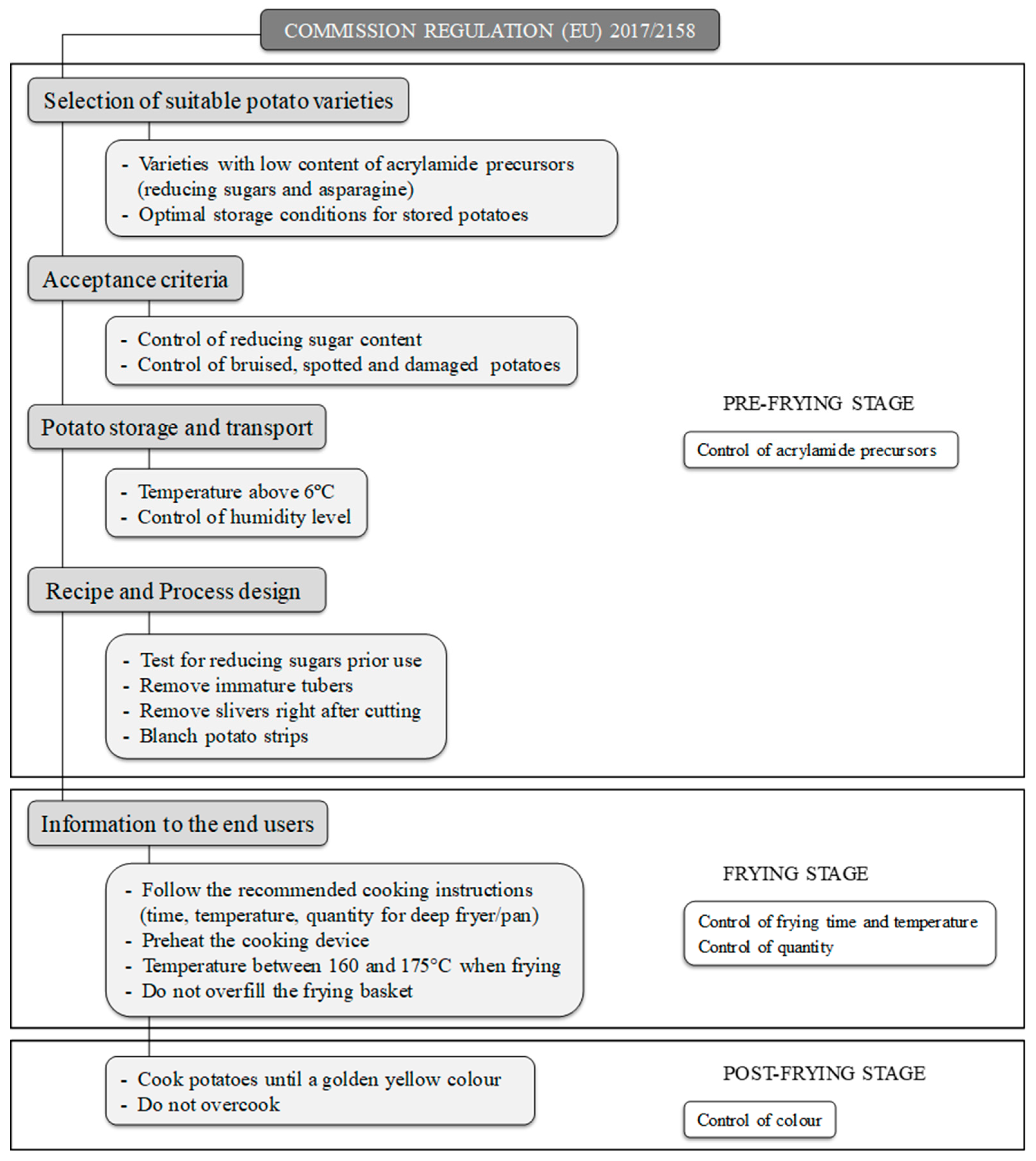
 daily,
daily,  weekly,
weekly,  monthly and
monthly and  exceptionally).
exceptionally).
 daily,
daily,  weekly,
weekly,  monthly and
monthly and  exceptionally).
exceptionally).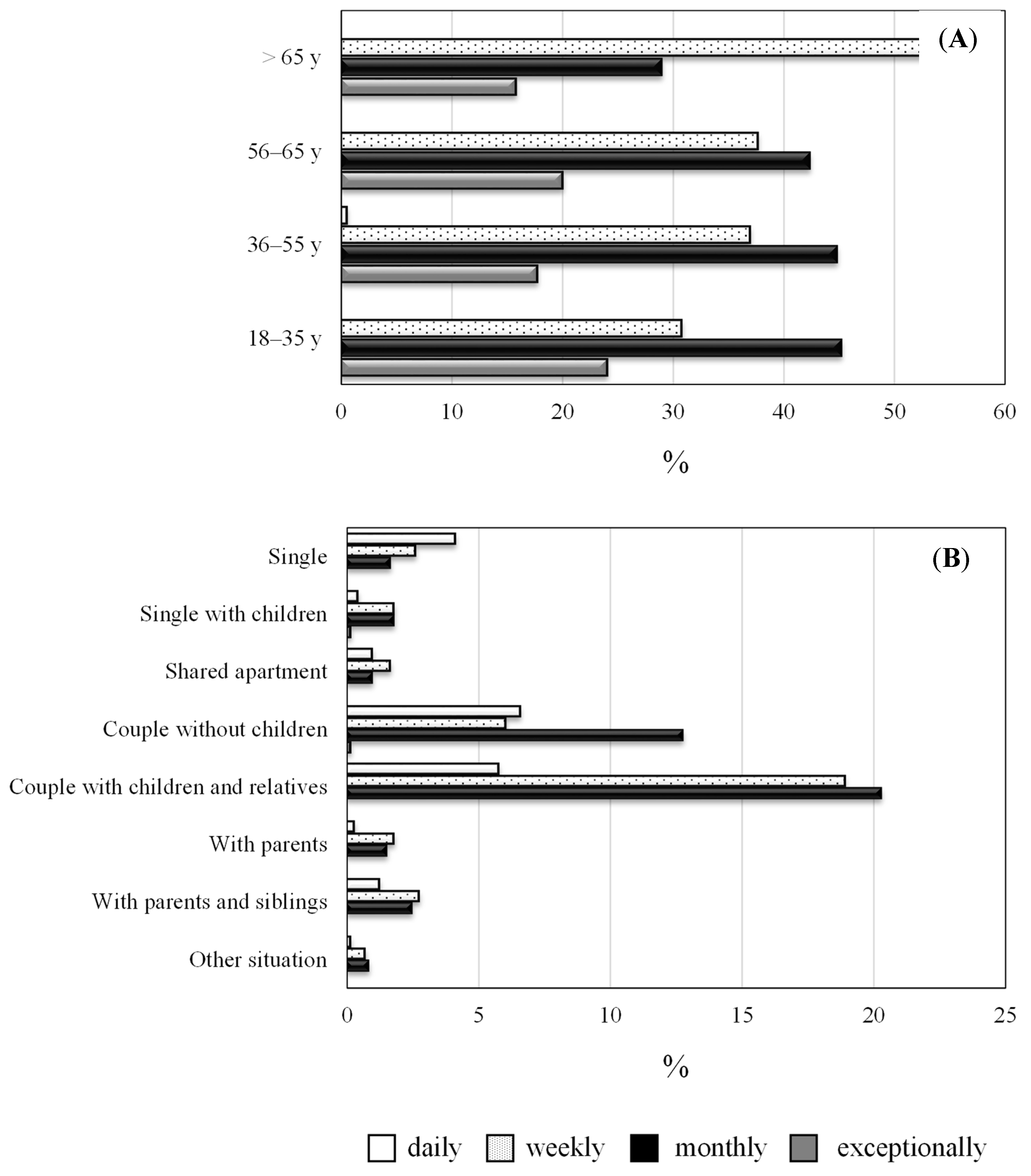
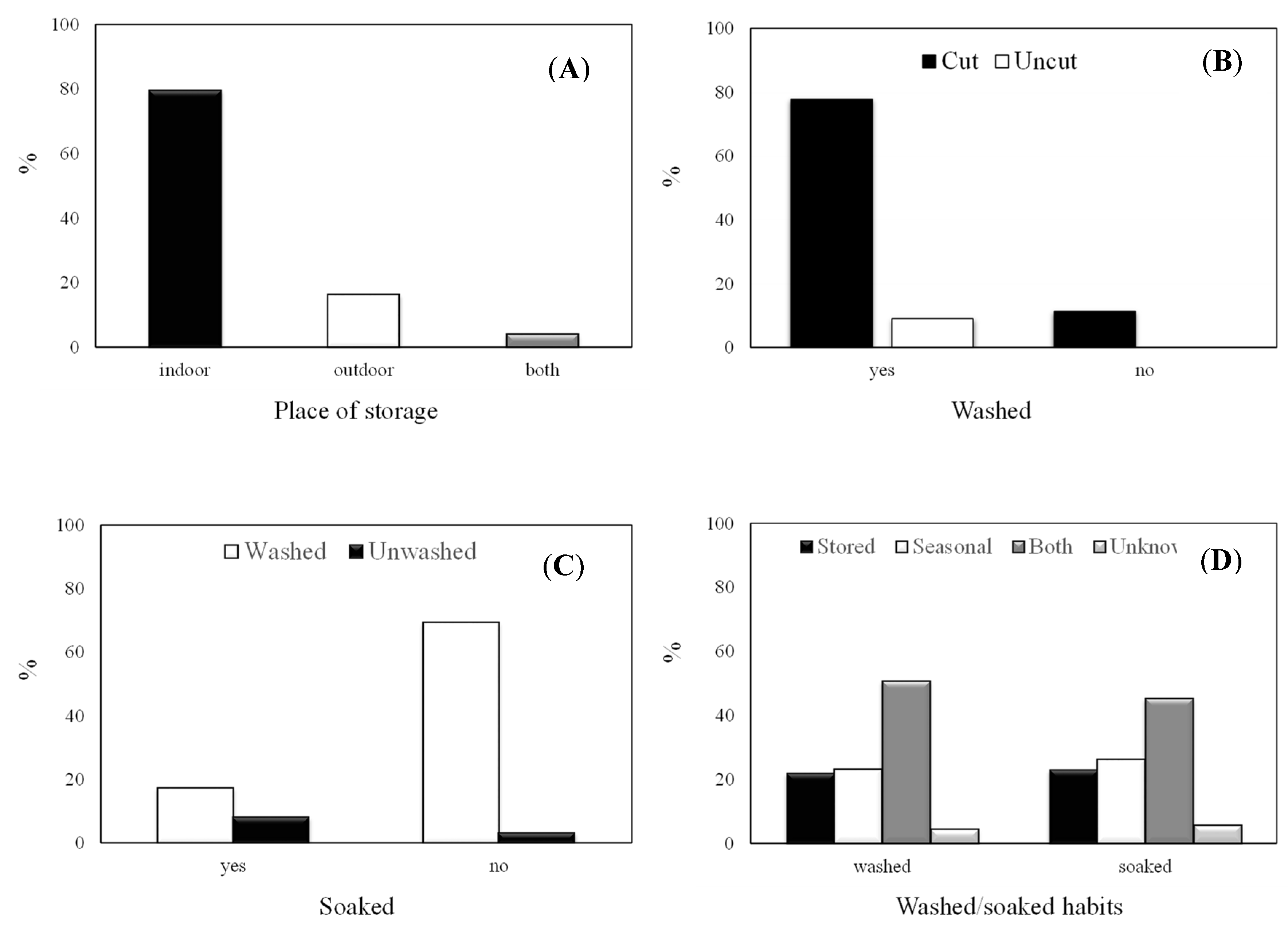
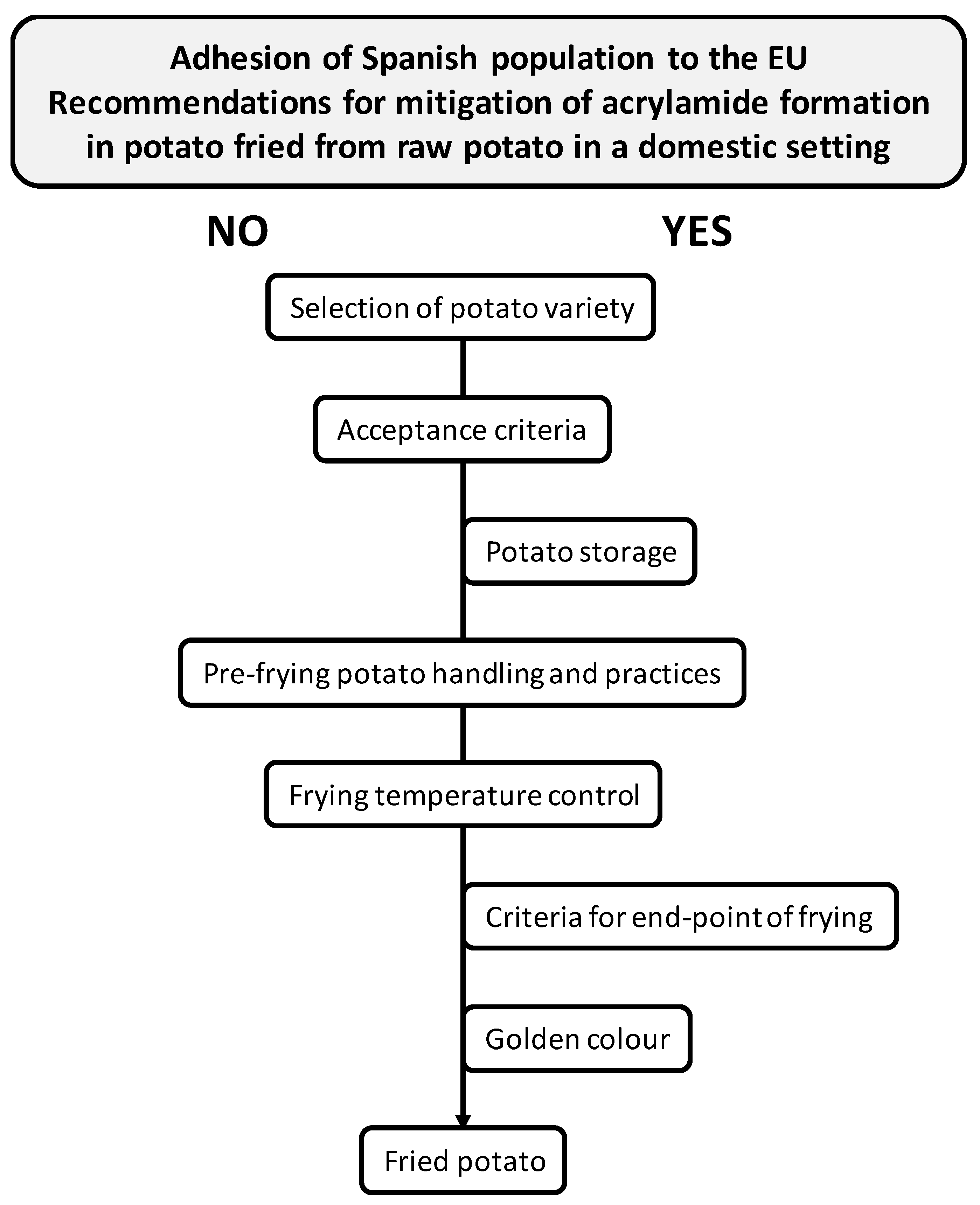
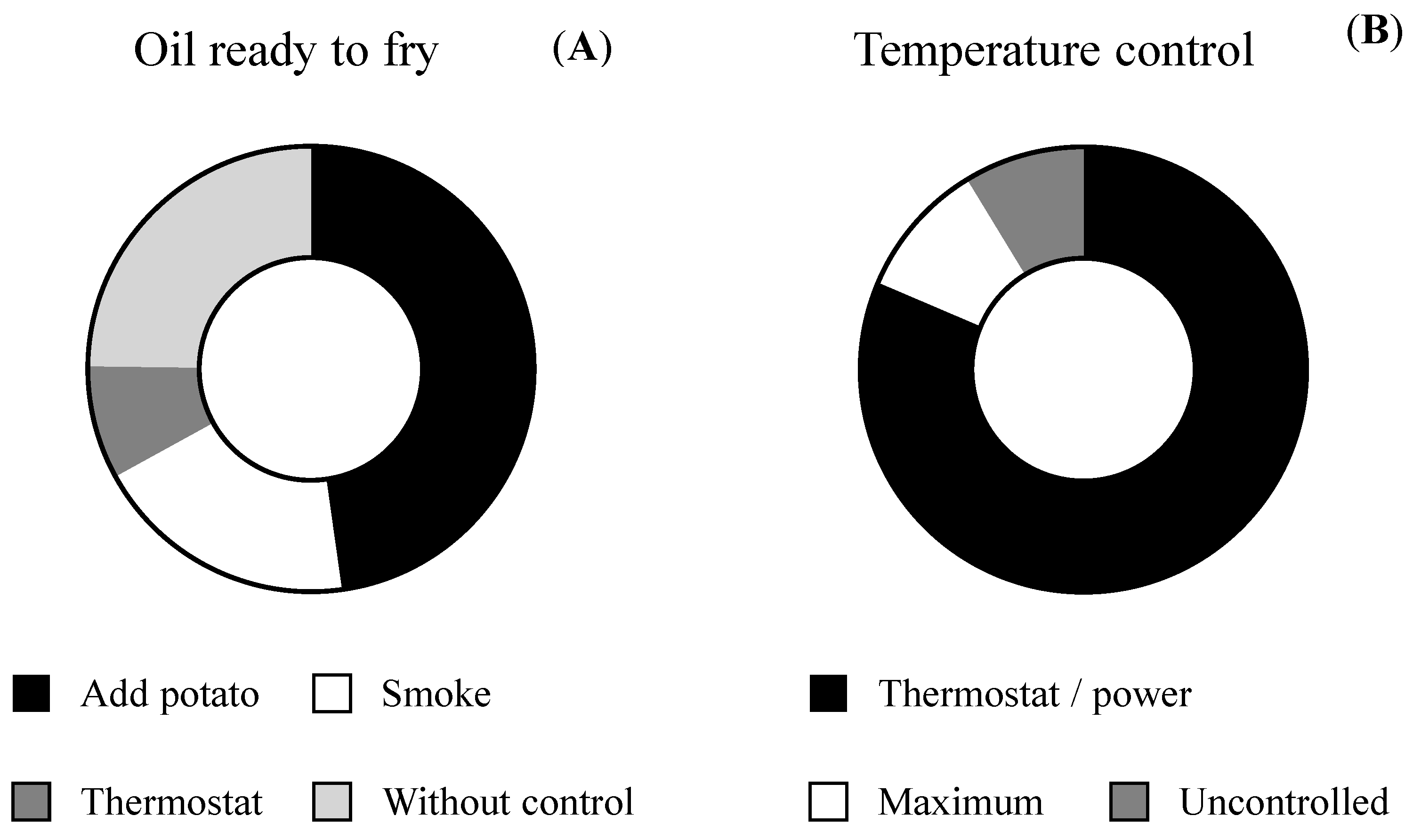
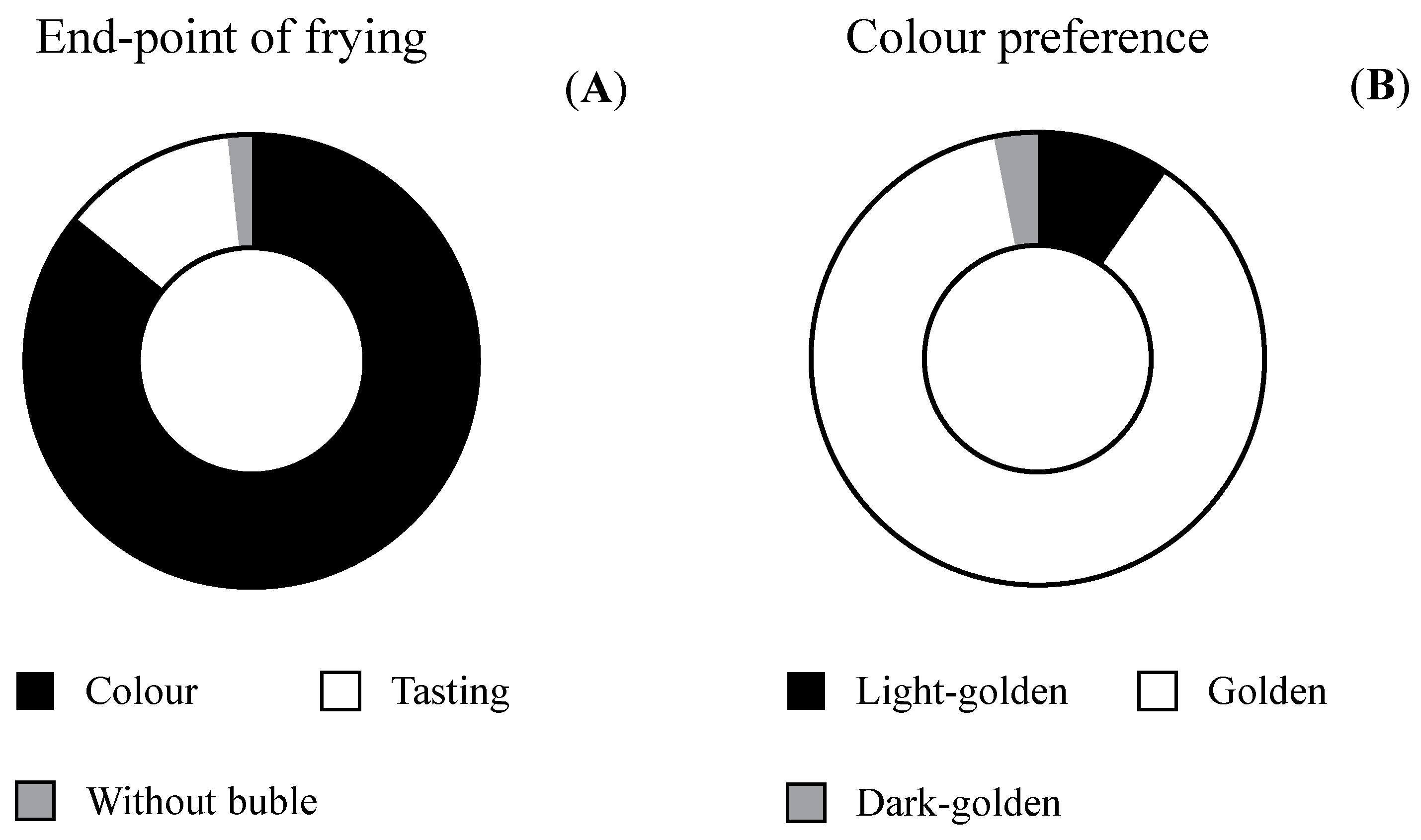
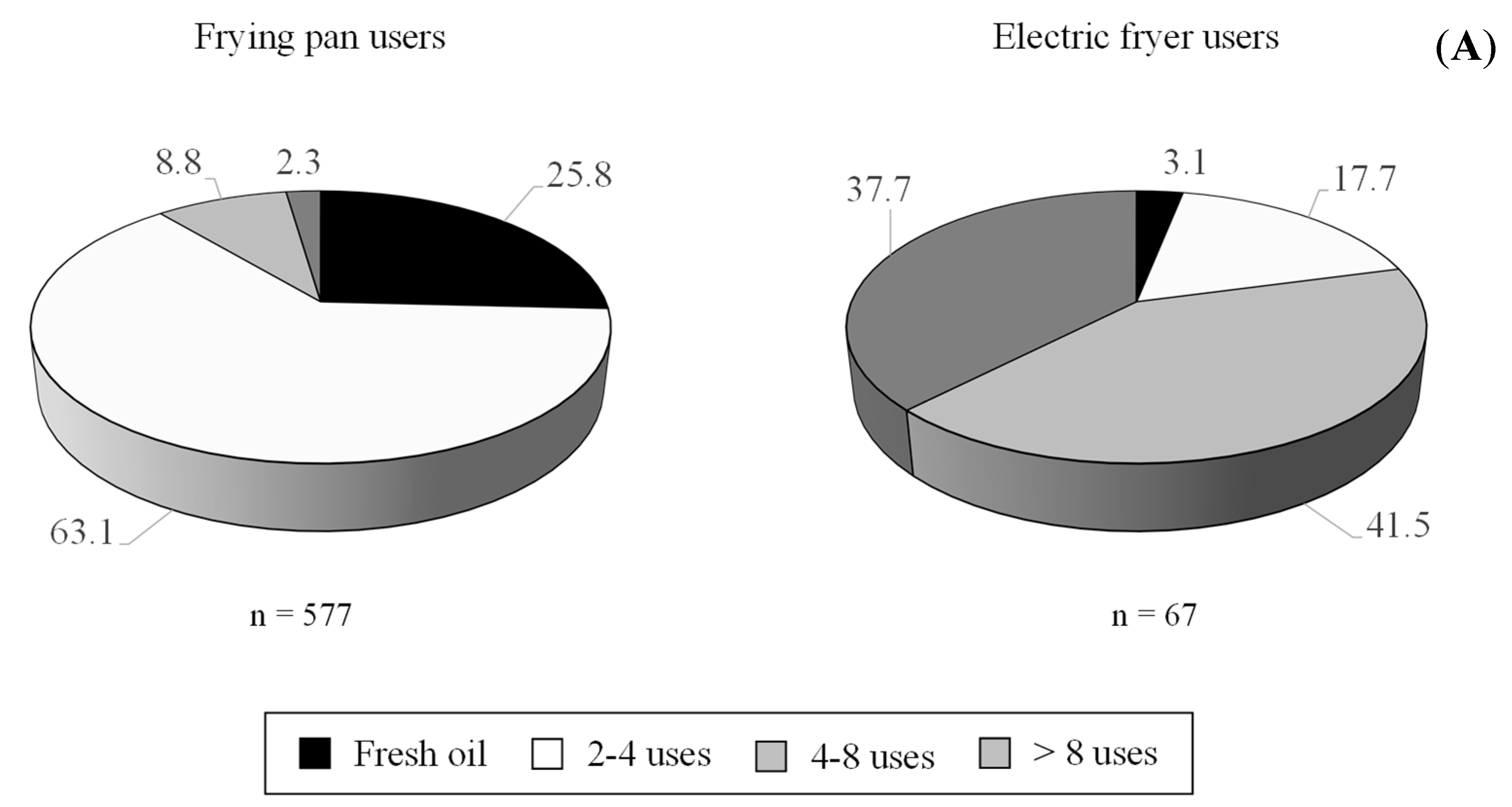
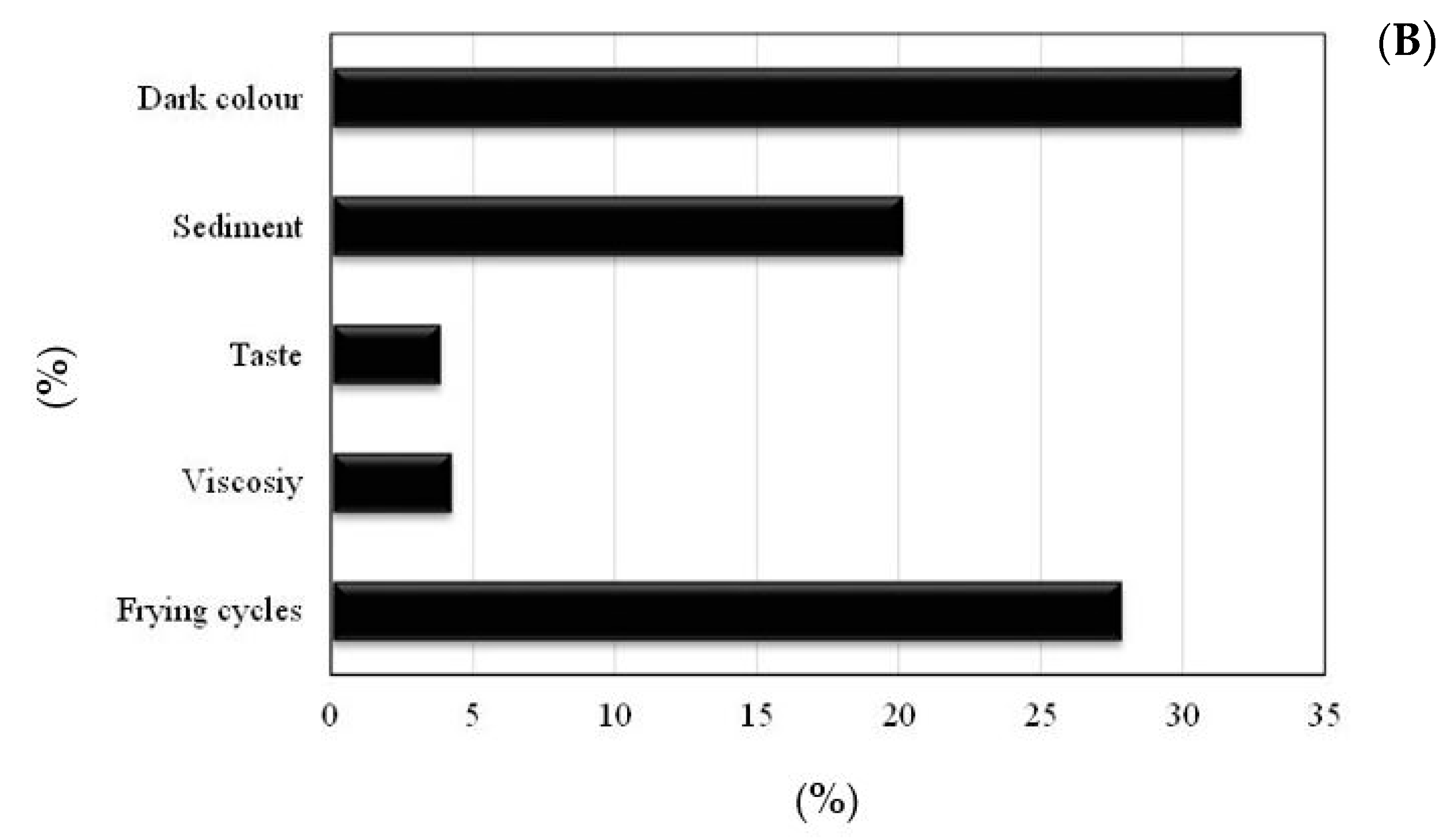
| Characteristic | n | (%) |
|---|---|---|
| Gender | ||
| Male | 190 | (26.0) |
| Female | 534 | (73.2) |
| Missing | 6 | (0.8) |
| Age group | ||
| 18–35 | 209 | (28.6) |
| 36–55 | 395 | (54.1) |
| 56–65 | 86 | (11.8) |
| >65 | 38 | (5.2) |
| Missing | 2 | (0.3) |
| Nationality | ||
| Spanish | 714 | (97.8) |
| Other than Spanish | 8 | (1.1) |
| Missing | 8 | (1.1) |
| Individuals < 18 at home | ||
| Yes | 290 | (39.7) |
| No | 434 | (59.5) |
| Missing | 6 | (0.8) |
| Individuals/home | ||
| 1 | 63 | (8.6) |
| 2 | 217 | (29.7) |
| 3 | 190 | (26.0) |
| 4 | 210 | (28.8) |
| 5 | 33 | (4.5) |
| >5 | 7 | (1.0) |
| Missing | 10 | (1.4) |
| Type of household | ||
| Single | 61 | (8.4) |
| Single with children | 30 | (4.1) |
| Shared apartment | 27 | (3.7) |
| Couple without children | 187 | (25.6) |
| Couple with children | 313 | (42.9) |
| Couple, children and relatives | 16 | (2.2) |
| With parents | 26 | (3.6) |
| With parents and siblings | 47 | (6.4) |
| Other | 12 | (1.6) |
| Missing | 11 | (1.5) |
| French Fry Consumption | ||||||||||
|---|---|---|---|---|---|---|---|---|---|---|
| fresh | frozen | not distinguished | missing 1 | |||||||
| Type | 623 | (85.3) | 21 | (2.9) | 84 | (11.5) | 2 | (0.3) | ||
| daily | weekly | monthly | exceptionally | missing 1 | ||||||
| Frequency of consumption | 2 | (0.3) | 262 | (35.9) | 318 | (43.5) | 144 | (19.7) | 4 | (0.6) |
| only french fries | as an accompaniment | missing 1 | ||||||||
| Consumption | 19 | (2.6) | 709 | (97.1) | 2 | (0.3) | ||||
| Fresh Potatoes | ||||||||||
| neighborhood stores | local markets | supermarkets | hypermarkets | missing 1 | ||||||
| Place of purchase 2 | 322 | (44.1) | 118 | (16.2) | 351 | (48.1) | 214 | (29.3) | 0 | (0.0) |
| only origin | only variety | both | no | missing 1 | ||||||
| Origin/variety | 103 | (14.1) | 84 | (11.5) | 264 | (36.2) | 278 | (38.1) | 1 | (0.1) |
| yes | no | unknown 3 | missing 1 | |||||||
| Special for frying | 113 | (15.5) | 517 | (70.8) | 98 | (13.4) | 2 | (0.3) | ||
| bulk | bagged | both | unnoticed 4 | missing 1 | ||||||
| Packaging | 268 | (36.7) | 205 | (28.1) | 255 | (34.9) | 0 | (0.0) | 2 | (0.3) |
| unwashed | washed | both | unnoticed 4 | missing 1 | ||||||
| Presentation | 99 | (27.3) | 316 | (43.3) | 171 | (23.4) | 44 | (6.0) | 0 | (0.0) |
| in-season | stored | both | unnoticed 4 | missing 1 | ||||||
| Seasonality | 358 | (49.1) | 31 | (4.2) | 164 | (22.5) | 176 | (24.1) | 1 | (0.1) |
| Pre-Frying Stage | ||||||||||
|---|---|---|---|---|---|---|---|---|---|---|
| yes | no | missing 1 | ||||||||
| Peeled | 712 | (97.5) | 2 | (0.3) | 16 | (2.2) | ||||
| yes | no | missing 1 | ||||||||
| Washed | 634 | (86.8) | 82 | (11.3) | 14 | (1.9) | ||||
| yes | no | missing 1 | ||||||||
| Soaked | 185 | (25.4) | 531 | (72.7) | 14 | (1.9) | ||||
| <15 min | 15–30 min | >30 min | ||||||||
| If soaking, duration | 126 | (17.3) | 43 | (5.9) | 16 | (2.2) | ||||
| before frying | during frying | after frying | no | missing 1 | ||||||
| Salt | 263 | (36.1) | 39 | (5.3) | 347 | (47.5) | 79 | (10.8) | 2 | (0.3) |
| strips | cubes | chips | irregular | slices | ||||||
| Type of cut 2 | 642 | (87.9) | 142 | (19.5) | 57 | (7.8) | 85 | (11.6) | 158 | (21.6) |
| Frying Stage | ||||||||||
| frying pan | electric fryer | both | other | missing 1 | ||||||
| Kitchen appliance | 577 | (79.0) | 67 | (9.2) | 63 | (8.6) | 23 | (3.2) | 0 | (0.0) |
| olive | sunflower | both | other | missing 1 | ||||||
| Type of oil | 574 | (78.7) | 128 | (17.5) | 20 | (2.7) | 7 | (1.0) | 1 | (0.1) |
| taste | price | health | performance | appliance | ||||||
| Criteria for oil selection | 375 | (51.3) | 116 | (15.9) | 468 | (64.1) | 132 | (18.1) | 25 | (3.4) |
| yes | no | unknown 3 | missing 1 | |||||||
| Special for frying | 51 | (7.0) | 535 | (73.3) | 144 | (19.7) | 0 | (0.0) | ||
| <half | half | >half | full | missing 1 | ||||||
| Potato/appliance surface | 59 | (8.1) | 187 | (25.6) | 247 | (33.8) | 235 | (32.2) | 2 | (0.3) |
| yes | no | not consumed | missing 1 | |||||||
| Defrosts frozen potatoes 4 | 6 | (0.8) | 100 | (13.7) | 621 | (85.1) | 3 | (0.4) | ||
| one | two | missing 1 | ||||||||
| Frying cycles | 696 | (95.3) | 22 | (3.0) | 12 | (1.7) | ||||
| Post-Frying Stage | ||||||||||
| soft | crunchy-soft | crunchy | missing 1 | |||||||
| Texture | 103 | (14.1) | 603 | (82.6) | 24 | (3.3) | 0 | (0.0) | ||
| paper | rack | both | none | missing 1 | ||||||
| Removal of oil | 424 | (58.1) | 114 | (15.6) | 154 | (21.1) | 36 | (4.9) | 2 | (0.3) |
| strainer | paper | decantation | no cleaning | missing 1 | ||||||
| Cleaning | 439 | (60.1) | 39 | (5.3) | 77 | (10.6) | 164 | (22.5) | 11 | (1.5) |
| used appliance | closed container | open container | no reusing | missing 1 | ||||||
| Storage | 133 | (18.2) | 384 | (52.6) | 102 | (14.0) | 103 | (14.1) | 8 | (1.1) |
© 2020 by the authors. Licensee MDPI, Basel, Switzerland. This article is an open access article distributed under the terms and conditions of the Creative Commons Attribution (CC BY) license (http://creativecommons.org/licenses/by/4.0/).
Share and Cite
Mesias, M.; Delgado-Andrade, C.; Morales, F.J. Are Household Potato Frying Habits Suitable for Preventing Acrylamide Exposure? Foods 2020, 9, 799. https://doi.org/10.3390/foods9060799
Mesias M, Delgado-Andrade C, Morales FJ. Are Household Potato Frying Habits Suitable for Preventing Acrylamide Exposure? Foods. 2020; 9(6):799. https://doi.org/10.3390/foods9060799
Chicago/Turabian StyleMesias, Marta, Cristina Delgado-Andrade, and Francisco J. Morales. 2020. "Are Household Potato Frying Habits Suitable for Preventing Acrylamide Exposure?" Foods 9, no. 6: 799. https://doi.org/10.3390/foods9060799
APA StyleMesias, M., Delgado-Andrade, C., & Morales, F. J. (2020). Are Household Potato Frying Habits Suitable for Preventing Acrylamide Exposure? Foods, 9(6), 799. https://doi.org/10.3390/foods9060799






